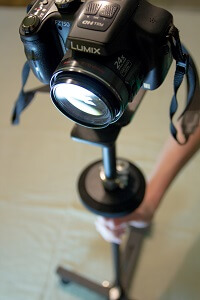I have kids. Which means I own a video camera. Which means I chase my kids around with my video camera, trying to catch them in action. And the footage always looks shaky and horrible.
So I’ve read more than my fair share of reviews about stabilizers, Glidecams and Steadicams. They rely on gimbals and counterweights to produce smooth, dream-like shots. But they’re often expensive, and some customers complain it takes forever to balance these contraptions.
About 15 years ago, Rene Kropf and his colleagues were experiencing the same frustration as they worked in his garage trying to design a tool that could help stabilize shaky film footage for light cameras.
“We went down the same route of counterweights and all that,” Kropf told me. “And we saw that as a nightmare. It’s like, the sun went down and we still haven’t balanced it, so forget that.”
 Kropf, the owner of Cobra Crane, a camera gear company in California, abandoned the gimbal system altogether. Instead, he helped devised something called the SteadyTracker Ultralite, a crowbar-like device with two adjustable weighted ends and a balancing pad in the middle that rests on top of your hand.
Kropf, the owner of Cobra Crane, a camera gear company in California, abandoned the gimbal system altogether. Instead, he helped devised something called the SteadyTracker Ultralite, a crowbar-like device with two adjustable weighted ends and a balancing pad in the middle that rests on top of your hand.
I recently bought the SteadyTracker UltraLite on Amazon. The SteadyTracker is touted as a simpler, inexpensive option compared to other stabilizers. I’ve been using it for a few weeks and produced some sample shots in this video review. When I called Cobra Crane with a few questions about the SteadyTracker, I was surprised to get a call back from Kropf, the company’s owner. He offered insights and tips that aren’t in the instruction manual.
Related: Why my trusty Sigma 17-70mm lens is always on my camera
“It’s relatively inexpensive,” Kropf said. “It’s pretty easy to use. And the biggest thing, the number one thing that people comment on, is it’s a super-quick set up, so you don’t miss shots.”
With the SteadyTracker, you attach your camera to a base plate on top. The plate can be adjusted back and forth and side to side. This YouTube video walks you through the process. It takes about five to ten minutes. If you plan to always use the same camera, you never have to tinker with it again. You’re all set.
The SteadyTracker’s simplicity is both a benefit and a drawback. Without gimbals or counterweights to worry about, it’s quick to set up. But so far I haven’t been able to consistently achieve silky smooth shots. My videos were certainly smoother than what I’d be able to achieve going handheld. But side-to-side wobbling occasionally cropped up in my video clips.
So as a stabilizer, the SteadyTracker is OK. But as a versatile piece of equipment, it really shines.
I took it to the birthday party of a friend’s daughter and was pleasantly surprised when I discovered I could use the SteadyTracker for a variety of shots. Its base is stable, so you can use it as a mini-tripod. Or you can hold it against your hip to steady your camera, like a monopod. Or use it for relatively smooth panning shots. Or hoist it on your shoulders to get overhead shots.
This means you can bring your camera and your SteadyTracker to something like a party, a wedding or a news event and you pretty much have all your shots covered. The real benefit of the SteadyTracker is that it’s more than a stabilizer.
Another cool thing about the SteadyTracker is that you can buy a “low-mode” attachment that hangs from the bottom to give you low-angle shots. Not many stabilizers offer this feature. Your camera skims across the ground. It’s great for getting down to the level of kids or pets. This is one of the main selling points of the SteadyTracker in my book.
One question I had was whether to use my camera’s image stabilization system. I had assumed that turning it on would help create smoother shots. But some manufacturers of other Steadicam-like products recommend deactivating it. Kropf said that in most cases, leaving it on will improve the SteadyTracker’s performance.
“In general, when you’re walking with it, I would put the stabilizer on,” Kropf said. Try to use a wide-angle lens to get a panoramic effect and smoother shots.
Instructions for the SteadyTracker UltraLite say it can handle cameras weighing up to three pounds. Cobra Crane also sells a SteadyTracker Xtreme that can handle cameras weighing up to eight pounds. But the UltraLite is a solid piece of gear — like I said, it feels like a crowbar. I asked Kropf if the three-pound limit was a hard-and-fast rule. He said it’s more of a rough guideline. If you’re over the limit by a bit but can still balance the SteadyTracker, you’ll be OK.
That said, the lighter the camera, the better. I used this with a Canon T3i, a wide-angle Sigma lens and an H1 Zoom external microphone set up that weighed 3.5 pounds. It didn’t take long for my arm to feel the strain. Using it with the lighter Panasonic FZ-150 was much easier and more enjoyable.
“The number’s there as a guide,” Kropf said of the three-pound limit. “It’s not a super-hard number. But at the same time, if you’re at six pounds, maybe you’re not going to be as balanced as you could be.”
What about the grip? Should you hold it loosely, tightly, or what?
“It varies,” Kropf said. “Most of the time, you wrap your hand around the fuselage. You wrap your fingers around it, but you don’t hold a tight grip. It’s sort of floating on the top of your hand. It’s a gentle touch, because this is all about that. It’s about gentle moves and smooth starts and stops. Gradual stuff.” The exception is when you’re tilting the SteadyTracker for shots such as Dutch angles.
The trick is reducing vibration produced by your hand, arm and body as you walk. Take small steps. The instructions suggest walking like Groucho Marx.
The SteadyTracker does not come with a quick-release plate, which is a bummer. You have to screw the camera directly into the base plate. For about $45 I bought a Manfrotto monopod head with its own quick-release plate and screwed it to the SteadyTracker’s base plate so I could quickly attach and remove my camera. The nice thing about this particular model is I can adjust its angle and tilt the camera up and down. It would have been nice if the SteadyTracker came with this option.
Overall, I liked the SteadyTracker’s versatility and I see its potential to help people like multimedia journalists who show up at a scene without knowing what to expect. Maybe a situation will call for following somebody through a crowd. Or filming the subject of a video from an overhead angle. Or a low-angle view. The SteadyTracker can handle all those situations. “It’s versatile,” Kropf said.
So the SteadyTracker is a useful tool for on-the-go videographers who film events — and chase their rambunctious kids around with a camera when they get home.
Update: This post was revised to reflect the fact that there are two versions of the SteadyTracker. The larger version was invented before Kropf helped develop the SteadyTracker Ultralite.
Sometimes I blog about stuff that helps journalists. I pay for all the products I review on my blog. To help defray those costs, I use Google ads and Amazon’s affiliate advertising program, which provides a way for sites to earn commissions by linking to Amazon.com. There’s no extra cost to you, and I’ll never link to stuff I don’t like or try to make you buy something that sucks. These reviews are my honest opinions. Thanks for reading.



